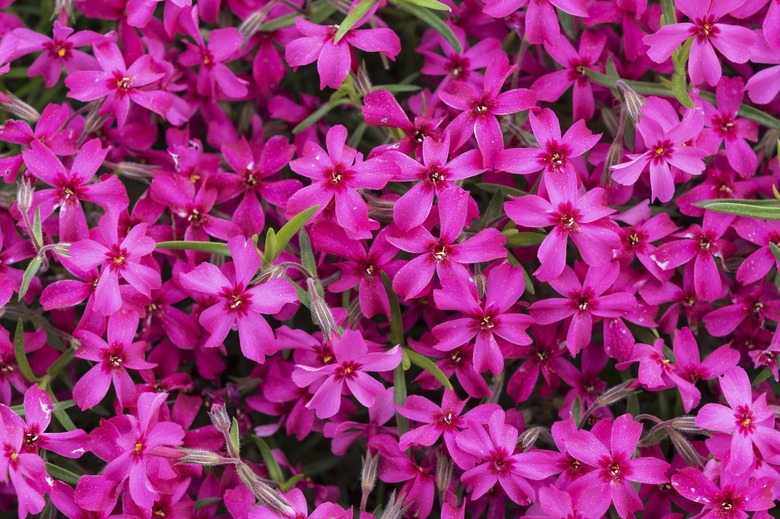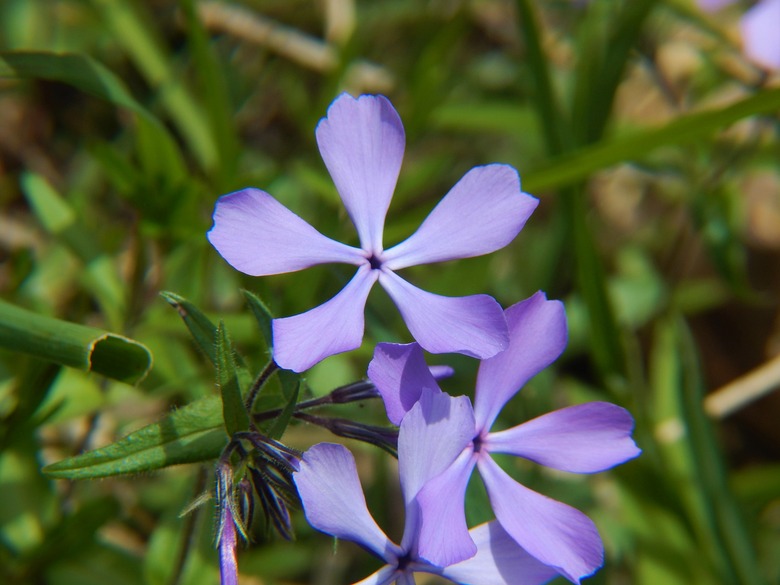How To Grow Phlox
We may receive a commission on purchases made from links.
Summer is an exciting and dramatic time in the garden, when blooming is at its peak and colors abound, but it's all over too soon as flowers finish their parts and leave the stage in early to mid August — but not phlox (Phlox spp.). A trouper all the way, phlox's bloom time extends all the way into September. This herbaceous perennial is native to North America, but it's the Europeans who have one-upped nature by developing fragrant, exotic cultivars with all the colors of the rainbow to keep your garden interesting all the way to the equinox.
Some phlox species grow low to the ground and can even creep, making it a great candidate for ground cover or foundation plantings, but the type that adorns most North American gardens in the summer is Phlox paniculata (USDA hardiness zones 4-8), a clumping plant that reaches heights of 3 to 5 feet and is laden with panicles of five-petaled, star-shaped flowers from midsummer to the beginning of fall. The word "phlox" comes from the Greek word for "flame," and phlox's flaming flowers can be pink, rose, lavender, purple, orange, white or combinations of these colors, and all those colors come with a sweet fragrance that wafts lusciously on the summer breeze.
The foliage is generally green, but some of the multitude of leaves that group themselves in pairs underneath each flower cluster may be outlined with a yellowish border. A dense perennial that can be used as a seasonal privacy screen in summer, garden phlox has no trouble weathering hot summer days in its growing zones, and it goes dormant in the winter. Creeping phlox (Phlox subulata, zones 3-9), on the other hand, is an evergreen that provides a deep-green carpet just waiting to be dusted with snow.
Best Uses for Phlox
Best Uses for Phlox
With numerous species and 100 cultivars, phlox is one of the most useful garden plants you can find. Creeping types make outstanding ground cover, and low-growing varieties can be used as border and foundation plantings. Phlox can tolerate shade and doesn't mind being overshadowed by trees or taller plants. Garden phlox adds color to cottage and meadow gardens and is a reliable late-summer source of cut flowers. With its pink, purple, blue or white flowers, adding creeping phlox to your woodland garden is a no-brainer.
You can combine phlox with any number of other flowers, the exact combination depending on the phlox cultivar, the application and your imagination. Phlox attracts bees and hummingbirds, so it's a great addition to the garden if you want to have more of these pollinators around, and it doesn't require a lot of maintenance as long as it gets plenty of air circulation. It is vulnerable to mildew in hot, humid climates, but several mildew-resistant cultivars are available, such as David (Phlox paniculata 'David'), with its white flowers, or Blue Flame (Phlox paniculata 'Blue Flame'), with its delicate sky-blue ones.
Phlox also has a place in your herb garden or close to it because it has medicinal uses. Indigenous North Americans have traditionally used the roots to treat stomach disorders and to create an eye wash, and the leaves can heal eczema when they are boiled to make tea or are made into a paste. When the leaves and flowers are pounded together, they make a stimulating body wash.
How to Grow Phlox
How to Grow Phlox
How to Start Phlox From Seedlings
How to Start Phlox From Seedlings
It's easiest to grow phlox from store-bought starts or divisions from your own existing phlox plants.
- Before planting, loosen the soil to a depth of 12 to 15 inches and mix in about 2 to 4 inches of compost.
- Space the plants 1 to 2 feet apart and dig a hole for each one that is about twice the diameter of its container.
- Place the plant in the hole with the top of the root ball at ground level, backfill and water thoroughly.
In What Zone Does Phlox Grow Best?
In What Zone Does Phlox Grow Best?
Phlox grows best in its natural habitat, which is the woodland areas of USDA hardiness zones 3 through 9 (depending on species and cultivar), where perennial species can last for decades. It is not drought-tolerant and won't do well in arid locations without regular watering, so it's a poor choice for a xeriscape landscape. While it prefers full sun, its woodland heritage makes it amenable to shade, especially at the southern extremes of its growing zone. In zones 3 and 4, where temperatures are cooler, phlox needs at least six hours of sunlight a day, so planting it on a south-facing slope with good drainage is ideal.
When Should You Plant Phlox?
When Should You Plant Phlox?
The best time to plant phlox is in spring after all danger of frost has passed. This is also the best time to divide existing phlox plants for replanting. If you're starting phlox from seed grown indoors, sow the seeds a good eight weeks before the last frost date.
Soil, Sunlight and Water Recommendations for Phlox
Soil, Sunlight and Water Recommendations for Phlox
Phlox prefers soil that is rich in organic matter and slightly alkaline with a pH between 6.0 and 8.0. A soil test is recommended, and if it indicates acidic soil with a pH below 6.0, work some lime in with the compost when you prepare for planting. Soil should be tested every three to five years, and more lime should be added as needed. Soil should also be well-draining, and planting on a slope is recommended if the soil has a high clay content.
Garden phlox prefers full sun, and although it doesn't mind shade, it will be happiest in a location that receives at least six hours of direct sunlight a day. It needs about 1 inch of water per week, so if you don't get that much rainfall, water your phlox plants regularly. To keep mildew at bay, direct water at the base of plants instead of the leaves and add organic mulch to help keep moisture in the soil.
How to Propagate Phlox
How to Propagate Phlox
Clumping phlox needs to be divided every few years. This prevents the stalks from overcrowding, which causes smaller blooms, and it promotes good air circulation, which helps prevent fungal infections. You can plant the divided stalks in the same way you plant new starts by digging a hole, placing them with the root balls at ground level, backfilling and watering.
The best time to divide garden phlox is in the early spring just after the plant emerges from dormancy, when you can clearly see how dense the clumps have become. You can also divide creeping phlox, and the best time for this is after the flowers have finished blooming. Simply dig around the roots with a spade, lift out a section and replant it elsewhere in the garden.
How to Winterize Phlox
How to Winterize Phlox
Cutting back garden phlox in the late fall is a good way to keep the plant vibrant and kill any powdery mildew that may have infected it, but don't do it too early or you'll rob the plant of the energy it needs to overwinter, which is supplied by the leaves. As a rule, you should wait at least until after the first killing frost to cut the plant down to the ground with sterilized pruning shears, but it's prudent to wait even longer, until after the second or third frost.
How to Harvest Phlox
How to Harvest Phlox
If you're a die-hard garden DIYer, you may want to harvest phlox seeds for planting in the spring. If so, prepare yourself for the possibility that the new plants will be different because not all phlox species and cultivars come true from seed. The harvesting procedure is simple:
- Leave one or two blooms on the plant and allow them to wilt and the seed pods to develop.
- Cut off the pods as soon as they turn brown. Don't wait too long or they'll open and drop the seed to the ground.
- Put the pods in a paper bag and store the bag in a warm, dry spot until they have completely dried.
- Break the pods open over a bowl, separate the seeds, put them in an envelope or sealed container and store them in a dark, well-ventilated place.
Garden phlox is a good source of cut flowers, and you can harvest blooms at any time for a colorful vase on a table. It's a good idea to deadhead spent flowers that you don't cut for your flower arrangements as soon as they wilt. That encourages the plant to produce more flowers.
Common Pests and Other Problems for Phlox
Common Pests and Other Problems for Phlox
Because phlox is a woodland plant, it isn't surprising that it attracts deer, and they can eat an entire plant to the ground in one night. The most effective way to control deer is to erect deer fencing around the yard. You might have some success with deer-repellent products such as Liquid Fence, but if the deer are hungry, they may ignore the disagreeable scent in favor of a good meal. You can also try growing plants that deer don't like, including prickly ones such as holly, strong-smelling ones like lavender or sage and toxic ones such as oleander, daffodil or poppy. A well-aimed and well-timed sprinkler system can also deter deer.
Phlox has its share of microscopic pests, including aphids and spider mites, which you can control with insecticidal soap. Leaf miners are small black and yellow flies whose larvae burrow into the leaves and disfigure them. When you spot their damage, simply remove the affected leaves; they won't kill the plant. Thrips are small insects that suck juices from the leaves, discoloring them. They can often be controlled by removing weeds and putting tinfoil on the ground between plants.
Common Diseases for Phlox
Common Diseases for Phlox
Perhaps the No. 1 disease affecting phlox is powdery mildew, a fungal disease that leaves a whitish or grayish deposit on the tops of the leaves and can cause the leaves to curl. When it strikes, it's a good indication that the phlox plants need to be pruned or divided because it can't grow if there is good air circulation. Other diseases that infect phlox when clumps are overcrowded and conditions are humid include fungal and bacterial ones:
- Rust is a fungus that forms rust-colored spots on leaves. Remove infected leaves or entire plants if necessary and prevent it by planting resistant cultivars.
- Bacterial leaf spot creates small spots on the leaves that grow into large, roughly circular ones with reddish centers. Remove infected plants and prevent this disease by watering at the base of plants and not the leaves.
- Septoria leaf spot is a fungal disease that forms circular gray spots on lower leaves. It occurs in rainy weather when clumps are overcrowded. Remove infected leaves and in addition to thinning affected clumps, spray them with a fungicide.


